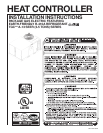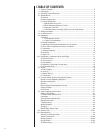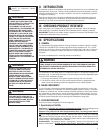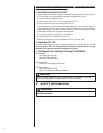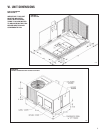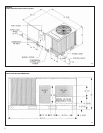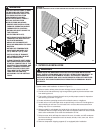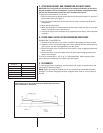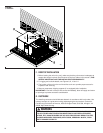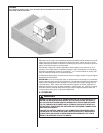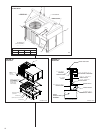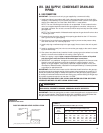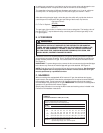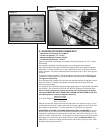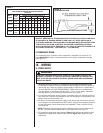
7
VII. INSTALLATION
A. GENERAL
Install this unit in accordance with The American National Standard Z223.1-latest edition
booklet entitled “National Fuel Gas Code,” and the requirements or codes of the local
utility or other authority having jurisdiction.
Additional helpful publications available from the “National Fire Protection Association”
are: NFPA-90A - Installation of Air Conditioning and Ventilating Systems 1985 or latest
edition. NFPA-90B - Warm Air Heating and Air Conditioning Systems 1984.
These publications are available from:
National Fire Protection Association, Inc.
1 Batterymarch Park
Quincy, MA 02169-7471
www.nfpa.org
1. PRE-INSTALLATION CHECK-POINTS — Before attempting any installation, care-
fully consider the following points:
Structural strength of supporting members
(Rooftop Installation)
Clearances and provision for servicing
Power supply and wiring
Gas supply and piping
Air duct connections and sizing
Drain facilities and connections
Location for minimum noise and
vibration - away from bedroom
windows
2. LOCATION CONSIDERATIONS
The metal parts of this unit may be subject to rust or deterioration in adverse envi-
ronmental conditions. This oxidation could shorten the equipment’s useful life. Salt
spray, fog or mist in seacoast areas, sulphur or chlorine from lawn watering systems,
and various chemical contaminants from industries such as paper mills and petrole-
um refineries are especially corrosive.
If the unit is to be installed in an area where contaminants are likely to be a
problem, give special attention to the equipment location and exposure.
1. Avoid having lawn sprinkler heads spray directly on the unit cabinet.
2. In coastal areas locate the unit on the side of the building away from the water-
front.
3. Shielding by a fence or shrubs may give some protection.
1. Frequent washing of the cabinet, fan blade and coil with fresh water will remove
most of the salt or other contaminants that build up on the unit.
2. Regular cleaning and waxing of the cabinet with a good automobile polish will pro-
vide some protection.
3. A good liquid cleaner may be used several times a year to remove matter that will
not wash off with water.
Several different types of protective coatings are offered in some areas. These coatings
may provide some benefit, but the effectiveness of such coating materials cannot be ver-
ified by the equipment manufacturer.
The best protection is frequent cleaning, maintenance and minimal exposure to
contaminants.
!
WARNING
DISCONNECT ALL POWER TO UNIT BEFORE STARTING MAINTENANCE.
FAILURE TO DO SO CAN CAUSE ELECTRICAL SHOCK RESULTING IN PER-
SONAL INJURY OR DEATH. REGULAR MAINTENANCE WILL REDUCE THE
BUILDUP OF CONTAMINANTS AND HELP TO PROTECT THE UNIT’S FINISH.
!
WARNING
ALWAYS INSTALL UNIT TO OPER-
ATE WITHIN THE UNIT'S INTEND-
ED TEMPERATURE-RISE RANGE
WITH A DUCT SYSTEM WHICH
HAS AN EXTERNAL STATIC PRES-
SURE WITHIN THE ALLOWABLE
RANGE, AS SPECIFIED IN DUCT-
ING SECTION OF THESE INSTRUC-
TIONS. SEE ALSO UNIT RATING
PLATE.
!
WARNING
WHEN A UNIT IS INSTALLED SO
THAT SUPPLY DUCTS CARRY AIR
CIRCULATED BY THE UNIT TO
AREAS OUTSIDE THE SPACE CON-
TAINING THE UNIT, THE RETURN
AIR SHALL ALSO BE HANDLED BY
DUCT(S) SEALED TO THE UNIT
CASING AND TERMINATING OUT-
SIDE THE SPACE CONTAINING
THE UNIT.
!
WARNING
NEVER TEST FOR GAS LEAKS
WITH AN OPEN FLAME. USE A
COMMERCIALLY AVAILABLE SOAP
SOLUTION MADE SPECIFICALLY
FOR THE DETECTION OF LEAKS
TO CHECK ALL CONNECTIONS, AS
SPECIFIED IN GAS SUPPLY AND
PIPING SECTION OF THESE
INSTRUCTIONS.



